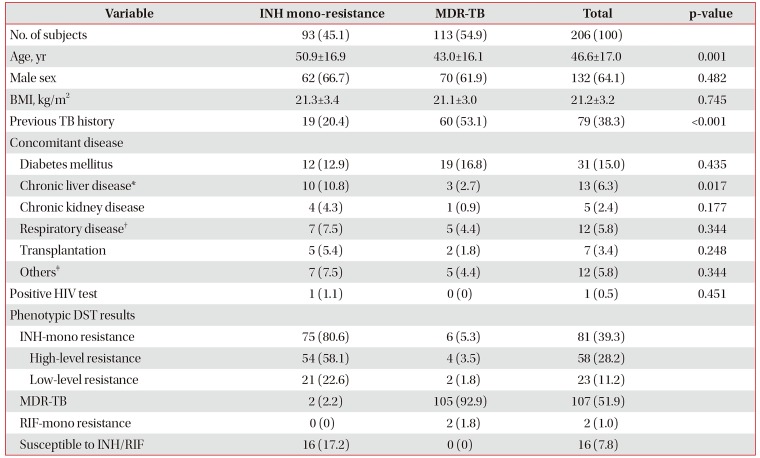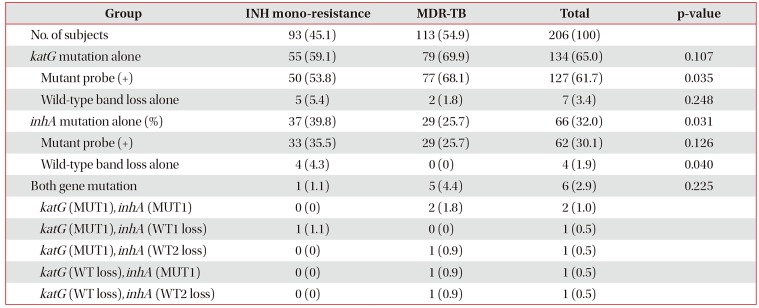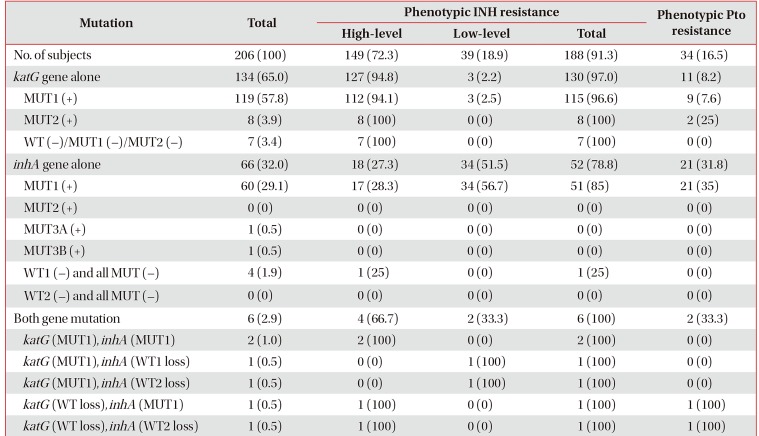1. World Health Organization. Global tuberculosis report 2016.WHO/HTM/TB/2016.13. Geneva: World Health Organization;2016.
2. Bai GH, Park YK, Choi YW, Bai JI, Kim HJ, Chang CL, et al. Trend of anti-tuberculosis drug resistance in Korea, 1994-2004. Int J Tuberc Lung Dis. 2007; 11:571–576. PMID:
17439684.
3. Korea Centers for Disease Control and Prevention. Annual report on the notified tuberculosis in Korea, 2016. Cheongju: Korea Centers for Disease Control and Prevention;2016.
4. Korea Centers for Disease Control and Prevention. Korean guidelines for tuberculosis third edition, 2017. Cheongju: Korea Centers for Disease Control and Prevention;2017.
5. World Health Organization. WHO treatment guidelines for drug-resistant tuberculosis, 2016 update. WHO/HTM/TB/2016.04. Geneva: World Health Organization;2016.
6. Leylabadlo HE, Kafil HS, Yousefi M, Aghazadeh M, Asgharzadeh M. Pulmonary tuberculosis diagnosis: where we are? Tuberc Respir Dis. 2016; 79:134–142.

7. Rouse DA, Li Z, Bai GH, Morris SL. Characterization of the
katG and
inhA genes of isoniazid-resistant clinical isolates of
Mycobacterium tuberculosis. Antimicrob Agents Chemother. 1995; 39:2472–2477. PMID:
8585728.
8. Guo H, Seet Q, Denkin S, Parsons L, Zhang Y. Molecular characterization of isoniazid-resistant clinical isolates of
Mycobacterium tuberculosis from the USA. J Med Microbiol. 2006; 55(Pt 11):1527–1531. PMID:
17030912.
9. Seifert M, Catanzaro D, Catanzaro A, Rodwell TC. Genetic mutations associated with isoniazid resistance in
Mycobacterium tuberculosis : a systematic review. PLoS One. 2015; 10:e0119628. PMID:
25799046.
10. Brossier F, Veziris N, Truffot-Pernot C, Jarlier V, Sougakoff W. Performance of the genotype MTBDR line probe assay for detection of resistance to rifampin and isoniazid in strains of
Mycobacterium tuberculosis with low- and high-level resistance. J Clin Microbiol. 2006; 44:3659–3664. PMID:
17021094.
11. Gali N, Dominguez J, Blanco S, Prat C, Alcaide F, Coll P, et al. Use of a mycobacteriophage-based assay for rapid assessment of susceptibilities of
Mycobacterium tuberculosis isolates to isoniazid and influence of resistance level on assay performance. J Clin Microbiol. 2006; 44:201–205. PMID:
16390970.
12. Lavender C, Globan M, Sievers A, Billman-Jacobe H, Fyfe J. Molecular characterization of isoniazid-resistant
Mycobacterium tuberculosis isolates collected in Australia. Antimicrob Agents Chemother. 2005; 49:4068–4074. PMID:
16189082.
13. Morlock GP, Metchock B, Sikes D, Crawford JT, Cooksey RC.
ethA,
inhA, and
katG loci of ethionamide-resistant clinical
Mycobacterium tuberculosis isolates. Antimicrob Agents Chemother. 2003; 47:3799–3805. PMID:
14638486.
14. Engohang-Ndong J, Baillat D, Aumercier M, Bellefontaine F, Besra GS, Locht C, et al. EthR, a repressor of the TetR/CamR family implicated in ethionamide resistance in mycobacteria, octamerizes cooperatively on its operator. Mol Microbiol. 2004; 51:175–188. PMID:
14651620.

15. Banerjee A, Dubnau E, Quemard A, Balasubramanian V, Um KS, Wilson T, et al. inhA, a gene encoding a target for isoniazid and ethionamide in
Mycobacterium tuberculosis. Science. 1994; 263:227–230. PMID:
8284673.
16. Lee H, Cho SN, Bang HE, Lee JH, Bai GH, Kim SJ, et al. Exclusive mutations related to isoniazid and ethionamide resistance among
Mycobacterium tuberculosis isolates from Korea. Int J Tuberc Lung Dis. 2000; 4:441–447. PMID:
10815738.
17. Lin SY, Desmond E, Bonato D, Gross W, Siddiqi S. Multicenter evaluation of Bactec MGIT 960 system for second-line drug susceptibility testing of
Mycobacterium tuberculosis complex. J Clin Microbiol. 2009; 47:3630–3634. PMID:
19741086.
18. Unissa AN, Selvakumar N, Narayanan S, Suganthi C, Hanna LE. Investigation of Ser315 substitutions within
katG gene in isoniazid-resistant clinical isolates of
Mycobacterium tuberculosis from south India. Biomed Res Int. 2015; 2015:257983. PMID:
25699262.
19. van Doorn HR, de Haas PE, Kremer K, Vandenbroucke-Grauls CM, Borgdorff MW, van Soolingen D. Public health impact of isoniazid-resistant
Mycobacterium tuberculosis strains with a mutation at amino-acid position 315 of
katG: a decade of experience in The Netherlands. Clin Microbiol Infect. 2006; 12:769–775. PMID:
16842572.
20. Gagneux S, Burgos MV, DeRiemer K, Encisco A, Munoz S, Hopewell PC, et al. Impact of bacterial genetics on the transmission of isoniazid-resistant
Mycobacterium tuberculosis. PLoS Pathog. 2006; 2:e61. PMID:
16789833.
21. Mokrousov I, Narvskaya O, Otten T, Limeschenko E, Steklova L, Vyshnevskiy B. High prevalence of KatG Ser315Thr substitution among isoniazid-resistant
Mycobacterium tuberculosis clinical isolates from northwestern Russia, 1996 to 2001. Antimicrob Agents Chemother. 2002; 46:1417–1424. PMID:
11959577.
22. Vilcheze C, Jacobs WR Jr. Resistance to isoniazid and ethionamide in
Mycobacterium tuberculosis: genes, mutations, and causalities. Microbiol Spectr. 2014; 2:MGM2-0014-2013.

23. Lei B, Wei CJ, Tu SC. Action mechanism of antitubercular isoniazid: activation by
Mycobacterium tuberculosis KatG, isolation, and characterization of inha inhibitor. J Biol Chem. 2000; 275:2520–2526. PMID:
10644708.
24. Vannelli TA, Dykman A, Ortiz de Montellano PR. The antituberculosis drug ethionamide is activated by a flavoprotein monooxygenase. J Biol Chem. 2002; 277:12824–12829. PMID:
11823459.

25. Machado D, Perdigao J, Ramos J, Couto I, Portugal I, Ritter C, et al. High-level resistance to isoniazid and ethionamide in multidrug-resistant
Mycobacterium tuberculosis of the Lisboa family is associated with
inhA double mutations. J Antimicrob Chemother. 2013; 68:1728–1732. PMID:
23539241.
26. Larsen MH, Vilcheze C, Kremer L, Besra GS, Parsons L, Salfinger M, et al. Overexpression of
inhA, but not
kasA, confers resistance to isoniazid and ethionamide in
Mycobacterium smegmatis,
M. bovis BCG and
M. tuberculosis. Mol Microbiol. 2002; 46:453–466. PMID:
12406221.
27. Vilcheze C, Weisbrod TR, Chen B, Kremer L, Hazbon MH, Wang F, et al. Altered NADH/NAD+ ratio mediates coresistance to isoniazid and ethionamide in mycobacteria. Antimicrob Agents Chemother. 2005; 49:708–720. PMID:
15673755.
28. Cardoso RF, Cardoso MA, Leite CQ, Sato DN, Mamizuka EM, Hirata RD, et al. Characterization of ndh gene of isoniazid resistant and susceptible
Mycobacterium tuberculosis isolates from Brazil. Mem Inst Oswaldo Cruz. 2007; 102:59–61. PMID:
17294000.
29. Niehaus AJ, Mlisana K, Gandhi NR, Mathema B, Brust JC. High prevalence of
inhA promoter mutations among patients with drug-resistant tuberculosis in KwaZulu-Natal, South Africa. PLoS One. 2015; 10:e0135003. PMID:
26332235.
30. Rueda J, Realpe T, Mejia GI, Zapata E, Rozo JC, Ferro BE, et al. Genotypic analysis of genes associated with independent resistance and cross-resistance to isoniazid and ethionamide in
Mycobacterium tuberculosis clinical isolates. Antimicrob Agents Chemother. 2015; 59:7805–7810. PMID:
26369965.
31. Tan Y, Su B, Zheng H, Song Y, Wang Y, Pang Y. Molecular characterization of prothionamide-resistant
Mycobacterium tuberculosis isolates in southern China. Front Microbiol. 2017; 8:2358. PMID:
29250048.

32. Han SB, Jo Y, Yu JK, Kim Y, Park YJ. Performance assessment of Advansure MDR-TB Genoblot Assay Kit for anti-tuberculosis drug susceptibility test. Lab Med Online. 2012; 2:34–40.








 PDF
PDF ePub
ePub Citation
Citation Print
Print



 XML Download
XML Download